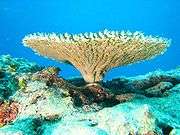Brain coral
| Brain coral | |
|---|---|
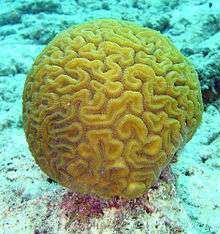 | |
| Diploria labyrinthiformis (grooved brain coral) | |
| Scientific classification | |
| Kingdom: | Animalia |
| Phylum: | Cnidaria |
| Class: | Anthozoa |
| Order: | Scleractinia |
| Family: | Mussidae Ortmann, 1890 |
| Genera | |
|
Agathiphyllia | |
Brain coral is a common name given to corals in the family Mussidae, so called due to their generally spheroid shape and grooved surface which resembles a brain. Each head of coral is formed by a colony of genetically identical polyps which secrete a hard skeleton of calcium carbonate; this makes them important coral reef builders like other stony corals in the order Scleractinia.
Brain corals are found in shallow warm-water coral reefs in all the world's oceans. They are part of the phylum Cnidaria, in a class called Anthozoa or "flower animals". The lifespan of the largest brain corals is 900 years. Colonies can grow as large as 1.8 m (6 ft) or more in height.
Brain corals extend their tentacles to catch food at night. During the day, they use their tentacles for protection by wrapping them over the grooves on their surface. The surface is hard and offers good protection against fish or hurricanes. Branching corals, such as staghorn corals, grow more rapidly, but are more vulnerable to storm damage.
Like other genera of corals, brain corals feed on small drifting animals, and also receive nutrients provided by the algae which live within their tissues. The behavior of one of the most common genera, Favia, is semiaggressive; it will sting other corals with its extended sweeper tentacles during the night. The genus and species have not been defined through the scientific classification segment.
Genera
- Barabattoai Yabe and Sugiyama, 1941
- Bikiniastrea Wells, 1954
- Caulastraea Dana, 1846 (candy cane coral)
- Colpophyllia Milne-Edwards and Haime, 1848
- Cyphastrea Milne-Edwards and Haime, 1848
- Diploastrea Matthai, 1914
- Diploria Milne-Edwards and Haime, 1848
- Echinopora Lamarck, 1816
- Erythrastrea Pichon, Scheer and Pillai, 1983
- Favia Oken, 1815
- Favites Link, 1807 (moon, pineapple, brain, closed brain, star, worm, or honeycomb coral)
- Goniastrea Milne-Edwards and Haime, 1848
- Leptastrea Milne-Edwards and Haime, 1848
- Leptoria Milne-Edwards and Haime, 1848
- Manicina Ehrenberg, 1834
- Montastraea de Blainville, 1830
- Moseleya Quelch, 1884
- Oulastrea Milne-Edwards and Haime, 1848
- Oulophyllia Milne-Edwards and Haime, 1848
- Parasimplastrea Sheppard, 1985
- Platygyra Ehrenberg, 1834
- Plesiastrea Milne-Edwards and Haime, 1848
- Solenastrea Milne-Edwards and Haime, 1848
Gallery
-
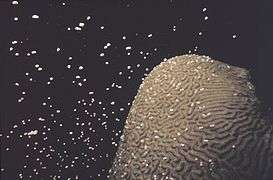
Brain coral spawning
-

Brain coral, Caribbean Sea near Esperanza on the island of Vieques, Puerto Rico
-

Black band disease on a brain coral in Caribbean Sea near Bahia de la Chiva on the island of Vieques
-
Close-up of a brain coral near Nusa Kode Island, Indonesia
-

Closeup of Diploria strigosa, Snapper Ledge, Florida Keys
-
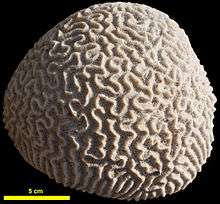
Diploria clivosa (dead), San Salvador Island, Bahamas
-

Fossil Diploria at the Windley Key Fossil Reef Geological State Park, of Pleistocene age
-

Diploria strigosa, in the near shore waters of Key West, FL
-
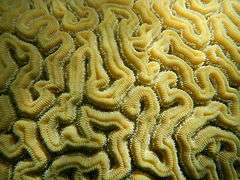
Close up of Diploria labyrinthiformis with visible polyps, Vieques, Puerto Rico
